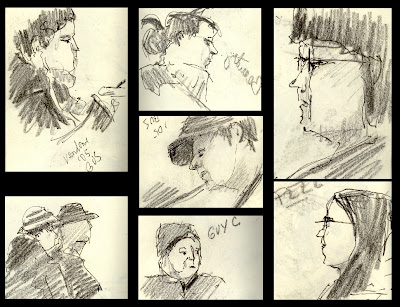Quick draw
The other day while riding the subway I decided to do one portrait per subway (Metro) station. In Montreal, on average it takes two minutes of travel time between stations, including twenty seconds of immobility while the train is in the station.

Strategy
Armed with a short stubby pencil and a fine point permanent marker, I initiate a quick contour in ink while the passengers embark and disembark. As the train pulls away from the station I take a second look at my model and darken or adjust key features. Then with my short stubby pencil I render the value with quick gesture/hash marks. Finally, as the car pulls into the station I write its name beside the sketch, switch back to my pen and start my next mini-portrait.
Gesture drawings for their own sake
Robert Kaupelis in his book Experimental Drawing says: “The general public often doesn't respond well to gesture drawings because they may have trouble "reading" them and, since they are done rapidly, they may feel that drawings which take hours longer have to be better.” My whole purpose while drawing in the Metro is not to “produce” a masterpiece. I am practicing. The inconvenience of drawing in a moving vehicle in a rather uncomfortable position invites me to zero in on the essentials, to observe intently and draw rapidly. It is one isolated but important facet of doing art. It is also a way of developing one’s unique way of drawing.
Other suggested tips
If you wish to try this exercise in a train, bus or subway car, here are some suggestions: Try to travel off peak hours so you can find a seat. During rush hour you may have to stand. If you do sit, passengers standing will block your view. I have also found it useful to lay my small sketch book over my back pack or jacket which rests on my knees. Somehow, this affords a comfortable drawing position. I also try to camouflage my sketch book with by my gloves, cap or hat. Sitting by a window seat is ideal. It is preferable to draw in the sketch book opened partially at 90 degrees in order to be discrete. Finally, avoid drawing in spiral books because they will attract attention to you.
Experimental Drawing
There are many “how to” books on drawing in book stores. Some are better than others. Once you have mastered the basics of drawing, I would suggest that you try some of the exercises suggested in a book such as Experimental Drawing by Robert Kaupelis. Here is an example: Make drawings from 20 five-second poses …Do another 20 drawings that are ten seconds in length …Gradually increase the time until you are producing one-, two-, and finally five-minute gestures. Kaupelis offers hundreds, maybe thousands of ideas!
A series of gesture drawings every day
Kaupelis says: “Gesture drawing is an absolute essential basic, and you should vow right now that you are going to produce some every day.” As long as I ride the subway or bus every day I practice this essential basic of drawing – regardless of what the result looks like. The process is what is important. Improvement comes in little bites over a long period.
"Verbum laudatur, si factum sequatur"
"Actions speak louder than words"
from Proverbs, Multilingual Anthology by Anthony D'Addese
Raynald Murphy sca









Aucun commentaire:
Enregistrer un commentaire